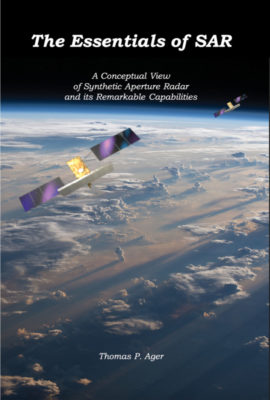- TomAger LLC, Lewes, Delaware,
- 2021. 253 x 178 mm, xvi + 291 pp, 257 color and black and white illustrations, 4 tables, index.
- Paperback, ISBN 9798512864487, $50.00 Amazon.
 Synthetic aperture radar (SAR) is an active sensing technology recognized as complementary to lidar. Many of us have struggled during our careers, however, with SAR textbooks in which the mathematics discouraged or intimidated us. LIDAR Magazine has covered SAR topics from time to time1 and acknowledged its value for mapping and measurement tasks. Yet it’s not as easy to understand as lidar and the plethora of physics concepts and the profusion of forbidding equations, often dripping with Fourier transforms and complex numbers, have rendered it somewhat inaccessible. Thus we accept the merits of the end-products and use them without fully comprehending how they were created or what can be derived from SAR data.
Synthetic aperture radar (SAR) is an active sensing technology recognized as complementary to lidar. Many of us have struggled during our careers, however, with SAR textbooks in which the mathematics discouraged or intimidated us. LIDAR Magazine has covered SAR topics from time to time1 and acknowledged its value for mapping and measurement tasks. Yet it’s not as easy to understand as lidar and the plethora of physics concepts and the profusion of forbidding equations, often dripping with Fourier transforms and complex numbers, have rendered it somewhat inaccessible. Thus we accept the merits of the end-products and use them without fully comprehending how they were created or what can be derived from SAR data.
This book aims to fix that. Tom Ager is president of TomAger LLC, but for most of his career fulfilled a variety of duties as a research and development program manager at the National Geospatial-Intelligence Agency. As a one-person company he currently advises one of the SAR smallsat start-ups, ICEYE, and pursues his passion by teaching SAR to both government and private clients across the globe. So he was a spook, but this is barely evident in either the language or the examples in the book—and his vast experience shines brightly. The subtitle gives an insight: A Conceptual View of Synthetic Aperture Radar and its Remarkable Capabilities. Throughout the book, as he reveals the properties of SAR, he often stops to comment on just how astonishing these are. The book is enhanced by quotations from authors well beyond the world of SAR—often the classics or music—and I relished his choice to start the book, from Francis Bacon, “There is no excellent beauty, that hath not some strangeness in the proportion.” This, therefore, is no ordinary SAR textbook.
Ager has grouped the 22 chapters into six “apertures”, an affectation perhaps but certainly more engaging than “parts”: the nature of SAR; the look of SAR images; an overview of SAR products; SAR and the geolocation revolution; SAR illumination and design considerations; imagining the future. Supporting material is printed on a blue background at the chapter ends and there are no less than 113 useful footnotes. There are equations, but they are straightforward and fastidiously explained.
The book is completed with three appendices—derivation of the antenna spacing constraint; measuring the ripples: how a SAR sensor records phase history data; how SAR processing improves the signal-to-noise ratio—and a list of symbols and acronyms. Although sources are formally cited throughout the book, there is no bibliography or suggestions for further reading. It would be contradictory, certainly, to recommend books for which Ager is pushing the cure!
Ager guides the reader gently, explaining concepts in words, introducing technical terms only when necessary, and illuminates the path with a stream of simple, well designed graphics, presumably developed for his own teaching, together with excerpts from SAR images and derived products. The material is not oversimplified, however, and deriving maximum benefit from his efforts requires concentration, re-reading of sections and referring back to concepts, symbols and acronyms used earlier. Indeed, your reviewer plans to read the book, cover-to-cover, a second time! Ager’s goal of rendering the technology comprehensible is unarguably met, yet along the way some formidable equations, for example for pulse repetition frequency and the signal-to-noise ratio, are derived in easy steps. Moreover, towards the end readers find themselves believing that they could say something intelligent during the design of an airborne or satellite SAR sensor.
The concepts are illustrated by examples from a wide variety of airborne and spaceborne SAR sources. A table of these, as an appendix, would be convenient and would, in the spirit of the book, be limited in scope, giving just launch dates, principal specifications and products, and country of origin. The danger, obviously, is that such information inevitably would quickly become outdated.
The Essentials of SAR is self-published and available on Amazon. It is pleasing to the eye and your reviewer found few errors or typos, although the author has indicated some minor improvements he would make if there were a second edition or reprint. Readers interested in SAR casually, professionally or scientifically, as well as consumers of SAR products who want to understand their purchases better, ought to buy this book. Ager has succeeded magnificently is his mission to explain SAR in terms that almost everyone can understand. He has given thought to a sequel–LIDAR Magazine would welcome it.
1 See, for example: Walker, A.S., 2017. Changing the guard: addressing complementary technologies, LIDAR Magazine, 7(8): 12-19, December 2017; and Walker, S., 2020, Dr. Joerg Hermann: senior vice president, special projects, Capella Space, LIDAR Magazine, 10(1): 38-42, January/February 2020.
